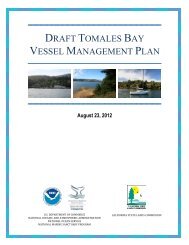Joint Working Group on Vessel Strikes and Acoustic Impacts Update
Joint Working Group on Vessel Strikes and Acoustic Impacts Update
Joint Working Group on Vessel Strikes and Acoustic Impacts Update
- No tags were found...
Create successful ePaper yourself
Turn your PDF publications into a flip-book with our unique Google optimized e-Paper software.
The purpose of this working group is torecommend acti<strong>on</strong>s to reduce ship strikes <strong>and</strong>ocean noise impacts to the sanctuary. Thisworking group will seek to achieve c<strong>on</strong>sensus inthe recommendati<strong>on</strong>s it provides to the SAC tothe fullest extent possible within the timeframeprovided (May 2011 through May 2012).
Co-ChairsLance Morgan, MCBI; CBNMS SACJackie Drag<strong>on</strong>, Greenpeace; GFNMS SAC alternate<str<strong>on</strong>g>Working</str<strong>on</strong>g> <str<strong>on</strong>g>Group</str<strong>on</strong>g> MembersMichael Jasny, Natural Resources Defense CouncilCarol Keiper, Oik<strong>on</strong>osJohn Calambokidis, Cascadia ResearchFrances Gull<strong>and</strong>, The Marine Mammal CenterJohn Hildebr<strong>and</strong>, <strong>Acoustic</strong>ian ScrippsJohn Berge, Pacific Marine Shipping Associati<strong>on</strong>Kathy Metcalf, Chamber of Shipping of AmericaCaptain Bill Mah<strong>on</strong>ey,CDR, Kiley Ross, USCG Inspecti<strong>on</strong>s <strong>and</strong> Investigati<strong>on</strong>s Branch ChiefPeter Fischel, SW Regi<strong>on</strong>al Office NMFS
Technical Experts/AdvisorsLeila Hatch, Stellwagen Bank Nati<strong>on</strong>al Marine SanctuaryCaptain Bruce Hort<strong>on</strong>, Port Agent SF Bar PilotsJohn Largier, Physical Oceanographer, UC Davis, Bodega Marine LabIngrid Overgaard, Ocean Noise <strong>and</strong> Policy Expert
•Balanced, Committed Membership•Closed Meetings•Focus: Large Commercial Traffic (Greater than 300gross t<strong>on</strong>s- AIS required)
•Case Studies•Stellwagen Bank NMS•Channel Isl<strong>and</strong>s NMS•Glacier Bay NP•LA/LB Clean PortsPrograms•Less<strong>on</strong>s Learned•Logistics
•Shipping•John Berge•Jackie Drag<strong>on</strong>•Michael Carver•Whale Behavior, Biology•Sara Wilkin•Frances Gull<strong>and</strong>•Carol Keiper•John Calambokidis•Jaime Jahncke
•Identify data gaps/needs•Identify potential partners for collating <strong>and</strong> analyzing regi<strong>on</strong>al data•Identify the AIS data (<strong>and</strong> sources)•<strong>Acoustic</strong> data needs: sources, source levels, receive levels•Which species are more vulnerable to ship strikes?•Will behavior changes be incorporated into a risk analysis?•Do observers make a difference?•Will slow speeds increase or decrease incidence of ship strikes?•10% or less of ship strikes are documented•What is the effect of speed reducti<strong>on</strong> <strong>on</strong> radiated underwaterpropagati<strong>on</strong>?•Support recommendati<strong>on</strong>s with sound science•Think outside of the box <strong>and</strong> ask industry for help c<strong>on</strong>sideringalternatives
•From: CBD, Friends of the Earth, EDC, PacificEnvir<strong>on</strong>ment•To: Office of Nati<strong>on</strong>al Marine Sanctuaries•Regulati<strong>on</strong> that establishes:A 10 knot speed limit for vessels greater than 65 feet withinthe Cordell Bank, Gulf of the Farall<strong>on</strong>es, M<strong>on</strong>terey Bay, <strong>and</strong>Channel Isl<strong>and</strong>s Nati<strong>on</strong>al Marine Sanctuaries to protectwhales from collisi<strong>on</strong>s with vessels <strong>and</strong> noise polluti<strong>on</strong>, <strong>and</strong> toprovide other benefits associated with reduced speeds thatwill further protect sanctuary resources
Collaborati<strong>on</strong> Between NMFS, CBNMS <strong>and</strong> GFNMSCALIFORNIA SEACOAST – WHALES – POINT AÑO NUEVO TO POINT REYES<strong>Vessel</strong>s transiting the shipping lanes between Point Año Nuevo <strong>and</strong> Point Reyesshould be aware of the potential presence of large whales, including blue whales,humpback whales, <strong>and</strong> fin whales, feeding in the area, particularly in theshipping lanes between May through December. These whales are endangeredspecies protected under federal law.Mariners should exercise cauti<strong>on</strong> when traveling around Cordell Bank, theFarall<strong>on</strong> Isl<strong>and</strong>s <strong>and</strong> entering/exiting San Francisco Bay, as whales may beencountered throughout these areas.Please report any collisi<strong>on</strong>s with whales or any observed injured or dead whalesto NOAA at 877-SOS-WHALE (877-767-9425) or to the U.S. Coast Guard.
Study Recommendati<strong>on</strong>s• Extend the northern TSS 17nm• Add a dog leg turn in the northernTSS to keep vessels <strong>on</strong> a predictablepath in a prime area for fishing.• Change the current flaredc<strong>on</strong>figurati<strong>on</strong> of the northern TSS to a3 mile wide approach.• Extend the western TSS 3nm seawardto the 200 fathom c<strong>on</strong>tour at the edgeof the c<strong>on</strong>tinental shelf.• Shift the seaward end of theoutbound lane closest to the Farall<strong>on</strong>Isl<strong>and</strong>s in the western TSS 3.7 nauticalmiles to the south.• Change the current flaredc<strong>on</strong>figurati<strong>on</strong> of the western TSS to a 3mile wide approach.• Extend the southern TSS 8.5NM







